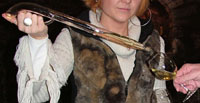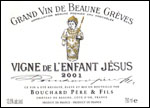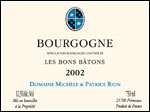![]()

Get
all the evaluations for
the February Release
Subscribe
to Vintage Assessments today
by Clicking
Here
This
not-for-profit website is dedicated to the discerning reader!
Great
2002
Burgundy
Expectations
Patrice
Rion's newest releases
National Post Weekly Wine & Spirits Columnist
Saturday, January 17, 2004
LIVE
WINE LINK
www.winefind.ca
(CLICK ON THE NAME - All
listings are automatically linked to the LCBO database)
If there is a product that interests you,
just click on the name below and you will instantaneously connected with
the LCBO database. The product will appear in blue and all you have to do
is click on the name again
and then the next screen will provide details along with the store search.
Just click on store search.
The number of bottles in each store is updated nightly. You should call
the store first to see if stock still remains (each
 It’s
a week before Christmas and I am standing in a cold cellar in Burgundy.
The winemaker is scurrying around from one barrel to another with his
glass pipette (wine thief),
drawing out samples while I struggle to make notes on the 2002 vintage.
It’s
a week before Christmas and I am standing in a cold cellar in Burgundy.
The winemaker is scurrying around from one barrel to another with his
glass pipette (wine thief),
drawing out samples while I struggle to make notes on the 2002 vintage.
After
four days, my 96-page book is filled. Synthesizing this into a cogent
article is challenging. The entire region has almost 100 appellations,
from Chablis to Chalonnaise (but excluding Beaujolais). The 40-kilometer Côte
d’Or is Burgundy’s heart with some 25 village
appellations (most producing Pinot Noir and Chardonnays), which are
further divided into 476 premiers
crus and 32 grands crus
vineyards.
Unlike
Bordeaux, where vineyards have a single owner, Burgundy has been divided
and subdivided for hundreds of years. Thus, a grower might own a couple of
rows (or parts of rows) here and there. It means that a single vineyards
may be dozens of grower/producers, each with its own viticultural agenda.
Burgundians
assert that the unique flavours are driven by the specific terroir
determined by vineyard site alone. There are, however, too many other
factors prior to the grapes arriving at the winery, to obfuscate these
pure stylistic considerations (see expert Clive
Coates’ introduction in his 1997-opus Cote
d’Or). Add to this, the myriad of existing winemaking
techniques and you have a huge number of variations on a theme.
 The
“monopole” vineyards, like Bouchard
Père & Fils 2000 Beaune Greves Vigne-de-l’Enfant-Jésus
(Vintages - 972554 $84.00), which are controlled/produced by a
single owner, have the best chance of providing a continuous taste of the
terrior.
The
“monopole” vineyards, like Bouchard
Père & Fils 2000 Beaune Greves Vigne-de-l’Enfant-Jésus
(Vintages - 972554 $84.00), which are controlled/produced by a
single owner, have the best chance of providing a continuous taste of the
terrior.
 Buying
Burgundy is extremely challenging. A house may produce from five to
several dozen wines annually. At Frederic
Magnein, a relatively small producer, I was confronted by 46
selections, including more than 12 different cru of Chambolle Musigny
alone!
Buying
Burgundy is extremely challenging. A house may produce from five to
several dozen wines annually. At Frederic
Magnein, a relatively small producer, I was confronted by 46
selections, including more than 12 different cru of Chambolle Musigny
alone!
There
are too many permutations to precisely understand where a specific
premiers cru originates. The grapes may come from the producer’s own
vines. To various degrees, it may also be mixed with purchased grapes. Or,
in the final analysis, even blended with purchased wine. In any case,
quantities are miniscule and real tasting windows few and far between. The
best is quickly bought up by discerning merchants, often on a repeat order
basis. People line up to get their allocation of great wine.
Unfortunately,
the LCBO has been left in the lurch with a real scarcity of fine Burgundy.
“The LCBO should be combing
Burgundy themselves like the SAQ,” says one agent. “Why
would I sell my best to the LCBO when I can make three times as much by
selling them directly to restaurants.” The solution? Go to the
upcoming 7th biannual Les
Grands Jours de Bourgogne from March 22-27 (see www.bivb.com)
 Patrice
Rion’s
tasting was a highlight. He broke away from his family operation (Domain
Daniel Rion) in 2001 and set up his own state-of-the-art operation in the
same Côte de Nuits village of Prémeaux. Rion’s wines are now better
than ever. There are many reasons. The first is the use of new sorting
tables (table de tri), which are
now used at the better Bordeaux chateaux. “Because of the heat, they were a life saver in 2003,” explains Rion.
“We had a tremendous number of
tiny, hard, dried-out berries. Our sorting tables came to the rescue
enabling us to get rid of these unwanted grapes.”
Patrice
Rion’s
tasting was a highlight. He broke away from his family operation (Domain
Daniel Rion) in 2001 and set up his own state-of-the-art operation in the
same Côte de Nuits village of Prémeaux. Rion’s wines are now better
than ever. There are many reasons. The first is the use of new sorting
tables (table de tri), which are
now used at the better Bordeaux chateaux. “Because of the heat, they were a life saver in 2003,” explains Rion.
“We had a tremendous number of
tiny, hard, dried-out berries. Our sorting tables came to the rescue
enabling us to get rid of these unwanted grapes.”
“The
key is limiting crop levels. To get better ripeness, we added an
additional wire to which the new vine leaves are trained. Lower, old less
energy generating leaves are removed, permitting better air circulation
and more sunshine to ripen the clusters. We also avoid pumping and even
forklift sorted grapes into our stainless steel tanks. Excessive
fruit-diminishing filtration is also avoided. The more a wine is handled,
the more it is hurt!”
These
steps are paying off big time, despite his small 5,000 cases. Production
is broken up between grapes he buys called Patrice Rion (PR) and wines made from his own
vineyards: Domaine
M & P Rion (M for Michèle his wife – M&P for short).
 There
is nothing everyday about his just-bottled M&P
2002 Bourgogne Bons Bâtons. Only 15 barrels were produced (450
cases) and it’s nicely structured with ripe cranberry and juicy cherry
flavours. His premium 2002 reds (tasted from barrels) soar towards heaven.
Of the many tasted, a slightly smoky, mouthfilling, ripe black cherry
driven PR 2002 Gevrey Chambertin seduces. Two domaine
wines are standouts: M&P
2002 Nuits St George 1er Cru Clos des Argillieres is perfectly
harmonious with juicy ripe black cherries that seem begging to be drunk;
the highlight, the complex, rich M&P 2002 Chambolle Musigny 1er Cru
Les Charmes is an opera of ripe plum, pomegranate and cherry
purée flavors. Those trying to find a good Rion wine to drink today
should check out the delicious, juicy, ripe cherry-driven PR
2001 Chambolle Musigny (918656)
at $56.65, which is currently available at many Vintage stores.
There
is nothing everyday about his just-bottled M&P
2002 Bourgogne Bons Bâtons. Only 15 barrels were produced (450
cases) and it’s nicely structured with ripe cranberry and juicy cherry
flavours. His premium 2002 reds (tasted from barrels) soar towards heaven.
Of the many tasted, a slightly smoky, mouthfilling, ripe black cherry
driven PR 2002 Gevrey Chambertin seduces. Two domaine
wines are standouts: M&P
2002 Nuits St George 1er Cru Clos des Argillieres is perfectly
harmonious with juicy ripe black cherries that seem begging to be drunk;
the highlight, the complex, rich M&P 2002 Chambolle Musigny 1er Cru
Les Charmes is an opera of ripe plum, pomegranate and cherry
purée flavors. Those trying to find a good Rion wine to drink today
should check out the delicious, juicy, ripe cherry-driven PR
2001 Chambolle Musigny (918656)
at $56.65, which is currently available at many Vintage stores.
Of
course, every winemaker has his own style, which isn’t fixed in stone.
At Domaine de Vougeraie,
for instance, expert Canadian winemaker Pascal
Marchand seems to have changed directions. His 2002’s have
much longer maceration concentrating tannins and flavours, meaning that
they are built for the long run. As a result they seem still tight and
peppery at the moment, especially when compared to his pretty 1999’s.
Time will tell. Note that I will be posting additional profiles and
tasting notes from a number of the other producers visited in the near
future.
2001-2002-2003 Tasting Note Database
Our tasting note database from December 3 1, 2000 to December 2003, covers every Vintages release product for the past 35 months. There are more than 5,000 notes in the database data. Just enter the name of the product, supplier name or CSPC number. Or you can search by type of wine, country of origin, even wine agent! Nothing could be easier. Also you can get information on the agent by clicking on the agent’s name, as well as current LCBO store inventory by clicking on "Check LCBO Availability", which will automatically tell you the number of bottles at LCBO as of last night.
To use our winefind.ca Tasting Notes Database: click here
Subscribe to Vintage Assessments Today • Click Here
|
** For All Visitors ** |
Copyright Food
& Beverage Testing Institute of Canada
2004
Prior written permission is required for any form of reproduction
(electronic or other wise) and or quotation.
Contact Michael Vaughan at
mbv@total.net